TheaterBlog: Let There Be Light, Installing the Projector
by Anand Lal Shimpi on March 25, 2008 12:00 AM EST- Posted in
- Anand
As I mentioned in my last post, the first projector I bought was the Panasonic AE1000U, an LCD based unit. The projector was decent but it wasn't bright enough. Projector technology advances quick enough that I was hoping to stay away from spending too much on a projector, since I could buy a new projector every year and probably be better off than spending $20K - $30K on a single projector today. That may not be the most popular thing to say but I believe it to be true. A lot of these AV custom installers push unnecessarily expensive (in my opinion) hardware, especially on the projector side, at you when the technology is really advancing too quickly for it to make sense. It's very much like the idea of buying a really expensive computer today with hopes of it lasting you 5 years, it just doesn't work that way.
I went to CEDIA last year to pick out what my next projector would be. Although I was blown away by the Sim2 C3X 1080, it carried a $30,000 MSRP. The Marantz VP15S1 was also interesting, but it was a single chip DLP and one of my good friends (Mike Andrawes, one of the original ATers) suffers from rainbows when watching any sort of single-chip DLP display. He'd kill me if I went with a single chip DLP projector, and the 3-chip models (e.g. Sim2) were far too expensive. If you look at used pricing on these $30K - $70K projectors a year or two after purchase, they depreciate worse than cars.

The screen with some cheap fabric installed, the good stuff remains upstairs until I'm ready to finish this thing. Say hello to my pops :)
I should, for a moment, talk about this whole concept of MSRP vs. street pricing in the consumer electronics world. The C3X 1080 projector I was talking about carries a MSRP of $30,000 but its street price is actually closer to $23,000. This is the case for most projectors I've found. I ended up with the JVC DLA-RS2, which has a MSRP of $8K but a street price of $6K. The problem is that there's no Newegg for projectors, so if you go to a local installer you'll most likely get quoted and charged MSRP, which in many cases is thousands of dollars above what you should be paying. I ordered my projector from the AV Science folks (the guys who run AVSforum), and while they don't allow for pricing discussion on the forums they actually have some of the most competitive pricing I've seen.
It's largely considered taboo to talk about street pricing publicly because the MSRPs are set so that the dealer/installer can be taken care of. Most of the CE press doesn't really talk about this discrepancy either. I'm not a big fan of that since it leaves the consumer with no advocate. If anyone out there is also interested in helping to rectify this situation, drop me an email - I've got some ideas :)
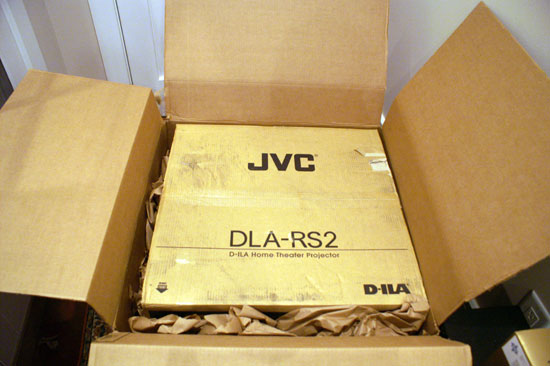
The RS2 arrives
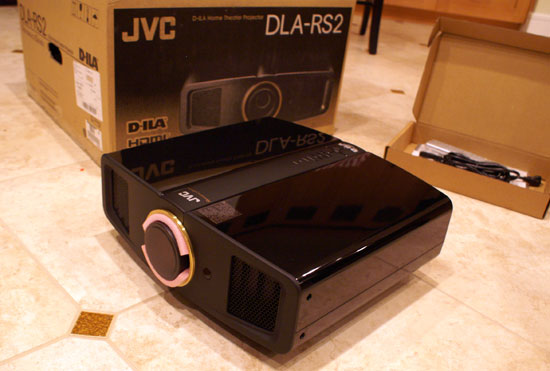
The RS2, it's shiny
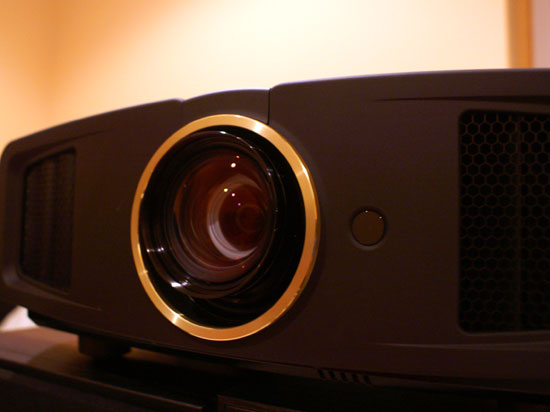
Ooh, lens-ey

The inputs
At the suggestion of Bryan Pape (the sound engineer I hired for the theater), I went with a Chief mount for the projector. I also ordered this from AVS.

This part mounts to the ceiling

The plate on the left attaches to the projector, the thing on the right latches onto the plate and allows you to adjust and level the projector along all three axes.
Originally I wanted to place the projector as close to the screen as possible, to maximize brightness. Here's a look at the mount installed on the ceiling (prior to the starfield ceiling going up):

When I first hung the projector up there I was incredibly nervous - I didn't trust the mount, or the stuff we screwed it in to. I think I stood up there holding it for a good 40 minutes before I started to trust it. The problem I had was mounting the anamorphic lens in front of it.
The ISCO III weighs about as much as the projector (15 lbs) but it's made out of metal and glass. Furthermore, it would be on a motorized sled so it could be moved in/out of the projector's path depending on whether or not I was viewing 2.35:1 content. The idea of this hunk of metal and glass, moving back and forth, suspended above everyones' heads in the theater just wasn't very comforting. I thought about making hardhats required, or keeping shovels nearby just in case there was an accident, but at the end of the day I realized that I'd feel much safer if I just tucked the projector and lens away in a soffit at the back of the room.
The end result was this:

That wood supported by metal will make sure no one dies from falling anamorphic lenses

Here's a blurry shot of the lens on its slide (on top of the bare frame for one of the rear columns)
I haven't quite figured out how I'm going to deal with the front of the hushbox, whether I'll just leave it open or maybe build a frame with a hole for the light to come out. But all I know is that I'm no longer worried about death in my theater.
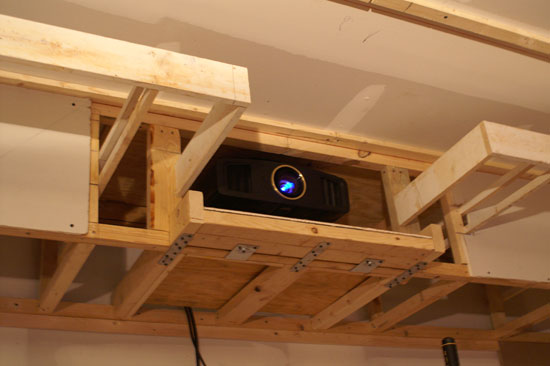
Projector in the hushbox
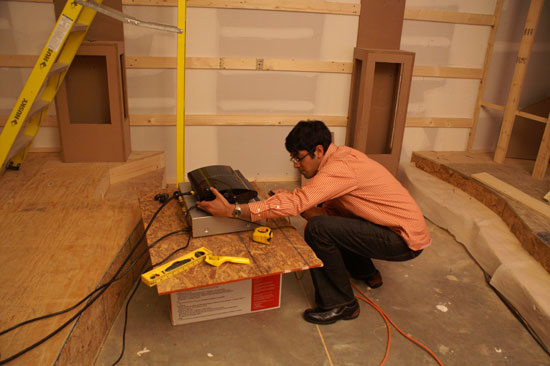
Manny setting up the PS3 to test out the projector
Of course I had to try it out:

A distorted blue image, let's see if we can't get something a little more interesting
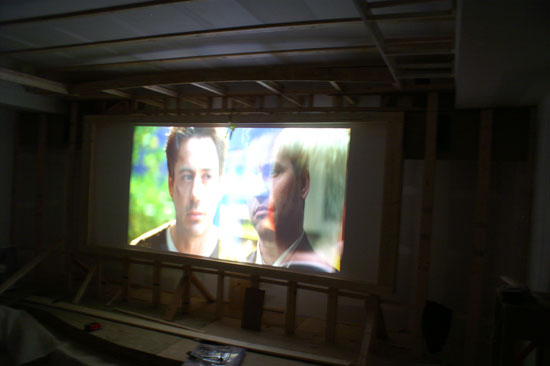
Ah, now we're getting somewhere - Kiss Kiss, Bang Bang (HD-DVD)
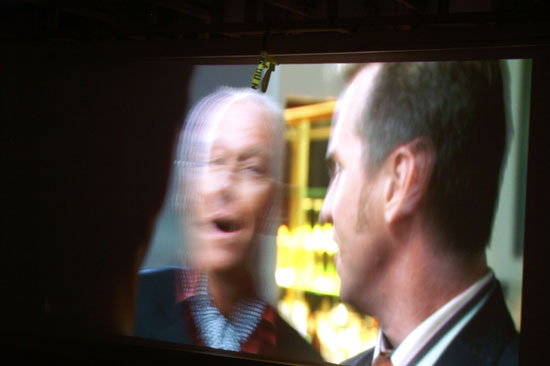
Val Kilmer in KKBB
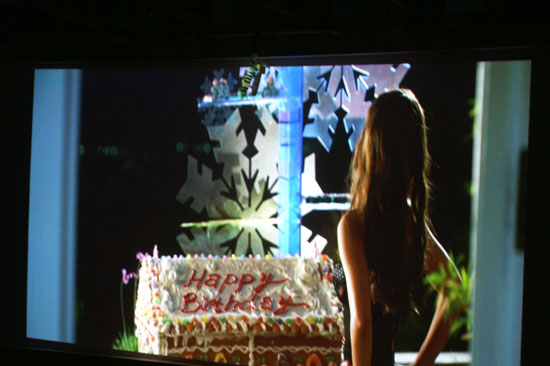
I suck at photography
This isn't calibrated, nor is the ISCO III in the way so I'm projecting a 16:9 image here. But oh am I ready for this thing to be watchable :)










24 Comments
View All Comments
nubie - Tuesday, March 25, 2008 - link
Wow, simply stunning, and unbelievable that you could use this for your TV with an antenna now that broadcast 1080 is becoming standard for primetime (now if only re-runs were :().@casteve, look a little closer, it is also the sync for VGA or RGB+Sync. Besides, if you just spent $6,000 on a projector and you couldn't connect it to any composite equipment, wouldn't you be a little miffed? I was surprised at the lack of VGA input, but realized the RGB probably covered it.
Best feature of your projector? Probably the analog overscan adjustments, I hate it when the image isn't pixel perfect, full screen be damned (on a projector "full screen" being the difference between 96" and 101" diagonal is not a big deal, but the inaccuracies caused by non-native pixel stretching is a huge deal).
Now to forget buying a house and pick up one of these bad boys :), or just watch the used market for one in about 4-5 years, when everyone is moving to QuadHD and Blu-Ray Xtra :D.
Keep up the good work, starting to look really good, I love the PS3 on particle board and a box, just had to hook it up ;).
Do you have plans for a comfortable foot-rest? That is the number one problem with the theater, I can't get comfortable without my legs properly supported, no hyperextension, but a slight bend and the back of your knees supported.
casteve - Tuesday, March 25, 2008 - link
Thanks for the update - I am so jeolous. Had to laugh when I saw the yellow rca jack for composite video input. Kinda contrary to the market segment.redsquid5 - Tuesday, March 25, 2008 - link
Putting the projector at the back of the room was the right decision, it would be no brighter if closer with the same image size.Once you add lenses, the brightness is just a factor of screen size; the same amount of light is going through to form the image.
(Light intensity drops with the square of distance for point sources.)
The advantage with the closer projector would be to keep head shadows out of the movie... Down in Front!
h0kiez - Tuesday, March 25, 2008 - link
Your comments about the PJ pricing are so true. Although I'm decidedly on the lower end of PJs, I've been through 3 PJs in as many years (Infocus 4805, Infocus 5000, and now Mits HD1000U) and will soon get a 1080 model. If you know how to shop around (which all of your astute readers surely know how to do), you can get a PJ, use it for a year, and sell it for not a whole lot less than you paid for it.Your analogy to PJ pricing vs. computer pricing is spot on too...I can't tell you how many times I've explained to people that they're better off with teh $500 PC and just buying a new one every couple of years.